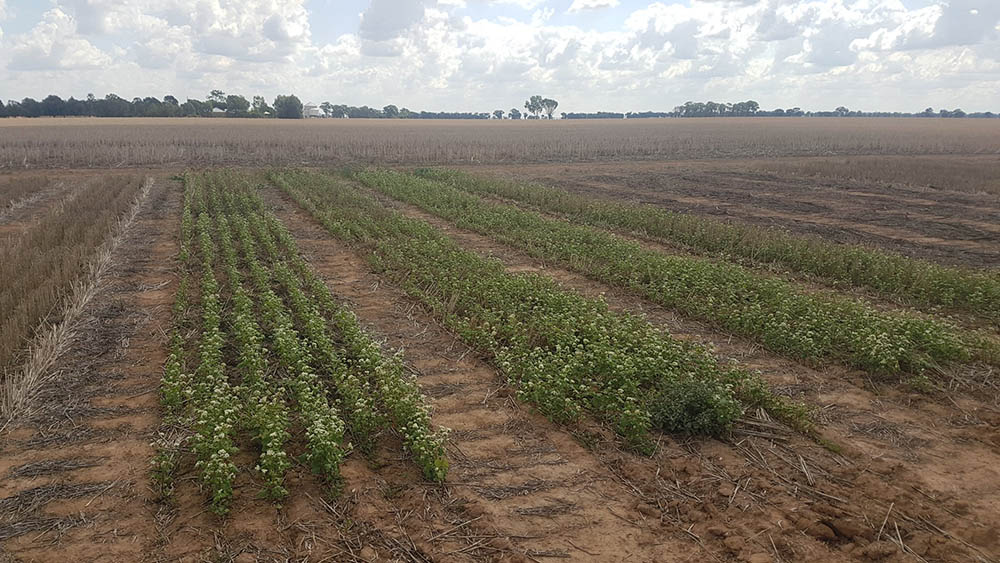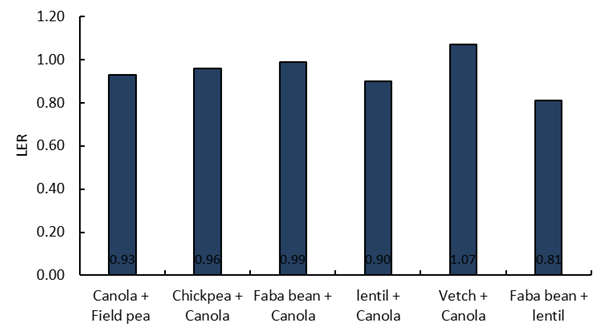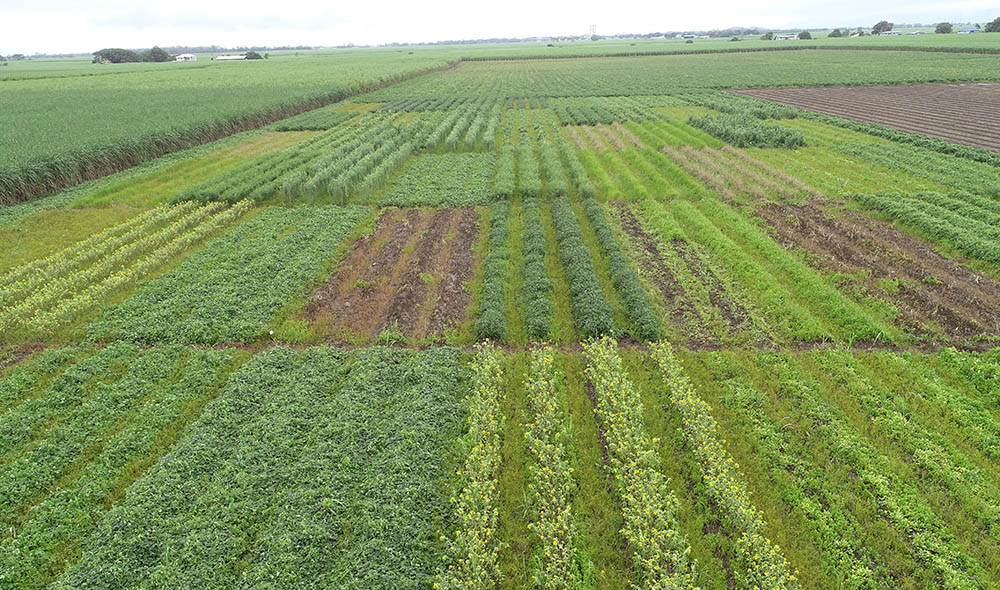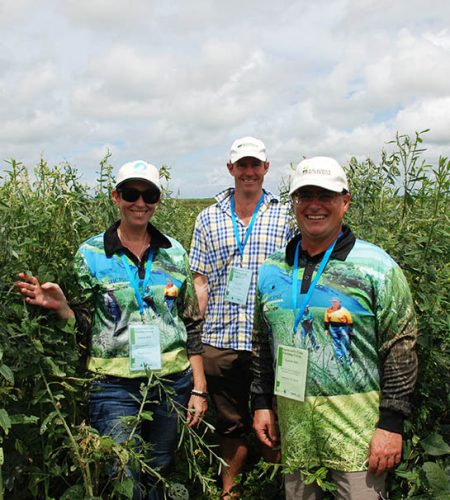Key Points
- Increased plant diversity in cropping systems typically increases soil microbial diversity, which in turn may be linked to improved soil function and farming system resilience.
- Temporary cereal-legume intercropping in southern Australian grain cropping systems and cover cropping in tropical sugar cane farming are promising options for increasing plant diversity and maintaining productivity.
- Summer cover crops have potential to be used tactically in southern Australian cropping systems, such as during wet seasons, but may not be suitable every season because their water use can affect subsequent winter crop yields.
The Challenge
Southern Australian cropping systems and tropical sugarcane production systems rely on a limited number of plant species in their rotations. This limits the diversity of carbon (microbial food) inputs into the soil and therefore the diversity of soil microbial populations.
Increased soil microbial diversity is linked to higher soil resilience. Finding economically viable ways to increase the diversity of plants in the farming system is a challenge, given that the cash crops grown in the existing rotations are generally the most profitable and low-risk options.
The Soil CRC’s ‘Plant-based solutions to improve soil performance’ project aimed to identify management options to increase plant diversity in the farming system, without vastly altering crop rotations and while also maintaining productivity.
Our Research
Five long-term field sites were established to investigate the impact of different management practices on soil function and crop yields. Research topics included:
Summer cover cropping in southern cropping systems – Explored the use of various summer cover crops as alternatives to traditional fallow periods, focusing on improving soil carbon levels and enhancing soil function. The research also examined the potential negative impact of water use by summer cover crops on winter crop yield where in-crop rainfall is scarce.
Temporary cereal-legume intercropping in southern cropping systems – Compared temporary intercropping of clover and vetch with wheat, measuring biomass, root density and depth, soil nitrogen, plant available water, crop yield and protein. Temporary intercropping is where multiple crops are sown and grown together for part of the season, with only one crop harvested.
Oilseed-legume intercropping in southern cropping systems – Evaluated the combined cultivation of oilseeds, such as canola, with legumes to assess potential synergistic effects on crop yields.
Perennial legumes in Western Australian cropping systems – The South African rangeland perennial legume Lebeckia ambigua, can grow on infertile subacid deep sandy soil under low-medium rainfall (<400 mm/yr). Incorporating a perennial legume into grains cropping has additional benefits including summer grazing options, soil stabilisation over summer and soil health improvements of unfertile sandy patches. A Lebeckia plot established in 2019 at Harrismith was oversown with wheat in 2021. The trial measured the impact on the wheat crop and soil properties (soil structure, soil organic matter).
Cover crops during the plough-out phase of sugarcane farming systems in the wet tropics – Explored how using cover crops as a break crop affect nematodes populations and AM (arbuscular mycorrhizae) fungal colonisation of subsequent cane roots. AM fungi form a symbiotic relationship with crops roots and help improve nutrient and water uptake, soil structure, drought resistance, and disease suppression. Cover crops included soybean, sunflower, sunn hemp, lablab, cowpea, pigeon pea, velvet bean, radish, Japanese millet, rice, burgundy bean and a mix of species.
The sites were established in conjunction with the project’s participant grower groups – Hart Field Site Group (SA), Facey Group (WA), Central West Farming Systems (NSW), Riverine Plains (Vic/NSW) and Herbert Cane Productivity Services (Qld).
Research Findings
Summer cover cropping in southern cropping systems
The summer cover crops generally produced less than 2 t/ha biomass and did not improve soil carbon over 3-4 years or lead to any consistent improvement in soil function. Summer cover crops in Australia’s southern cropping regions are not feasible during dry conditions because it is difficult to establish the crops and once established, the cover crops can use subsoil water that may otherwise be used by the following winter crop.
All summer cover crop species examined used subsoil water. Legumes, especially cowpea, as well as mixed-species cover crops, tended to have more roots in deeper soil layers and used more water from these layers.
However, summer cover crops can be strategically used in wet seasons to increase plant diversity, crop carbon inputs and to manage erosion.

Temporary cereal-legume intercropping in southern cropping systems
The choice of legume species matters. Intercropping clovers with wheat had little impact on soil function, likely due the minimal amount of biomass produced by clovers. The only significant impact was a reduction in the soil enzyme NAG (N-acetylglucosaminidase) which is involved in the breakdown of chitin (the main component of fungal cell walls). What this means for the crops and soil function is being researched in a new Soil CRC project, ‘Building soil resilience and carbon through plant diversity’ (4.1.007).
Vetch, on the other hand, produced around 250 kg/ha of biomass, contributing 10 kg of nitrogen (N)/ha in shoots. Vetch-wheat intercropping also led to greater wheat root density in deeper soil layers, an additional 20 kg soil mineral N/ha and 30 mm plant available water to 90 cm depth at anthesis. This additional water may have benefits for grain yields and protein in seasons where water is limiting during grain fill.
Oilseed-legume intercropping in southern cropping systems
Legume-oilseed intercropping did not provide consistent yield benefits, with the monocrops out-performing the intercrops. These results contrast those from other studies in the region and further investigation is needed.
Land Equivalent Ratios (LER) assess the relative yield advantage of growing two or more crops together compared to growing them separately. Values greater than 1.0 indicate intercropping is more productive than the individual crops. Land Equivalent Ratios values for most combinations were less than 1.0 (Figure 2). In 2022, the vetch-canola intercrop was the only legume-oilseed combination that resulted in an LER value greater than 1.0 at 1.07.

Perennial legumes in Western Australian cropping systems
Results from three seasons at Harrismith, WA, found that oversowing wheat onto Lebeckia led to a significant increase in shoot biomass and yield production, with yield increasing by 0.8 t/ha compared to the control.
Soil health improvements are still under investigation as more time is required to allow for changes to soil properties.
Using cover crops during the plough-out phase of sugarcane farming systems in the wet tropics
In sugarcane farming systems in the wet tropics, cover crops:
- added substantial amounts of carbon to soils (5 – 10 t/ha of biomass)
- fixed nitrogen (N) – most legumes fixed more than 50 kg N/ha (further work is needed to determine if these fixed-N contributions can reduce N fertiliser requirements of subsequent cane crops)
- suppressed weeds
- did not reduce cane yields compared to a conventional fallow.
However, no cover crop treatment resulted in increased AM fungal colonisation or decreased pathogenic nematode counts in subsequent plant cane and ratoon cane crops.
Mixed species cover crops mitigated the risk of failure of any single species in a given season, which is particularly important in the wet tropics where extreme weather events are not uncommon.

Significance Of Findings
Growers have options to increase plant diversity and soil resilience without compromising productivity. The Soil CRC’s ‘Plant-based solutions to improve soil performance’ project identified a novel practice, temporary cereal-legume intercropping, that offers potential to integrate legumes into the farming system with little need to change other farming practices.
Next Steps
Temporary cereal-legume intercropping, oilseed-legume intercropping, and summer cover cropping will be examined further at two of the Soil CRC’s long-term trial sites to investigate longer-term impacts on soil performance and system productivity. This work is part of the Soil CRC’s ‘Building soil resilience and carbon through plant diversity‘ project.

